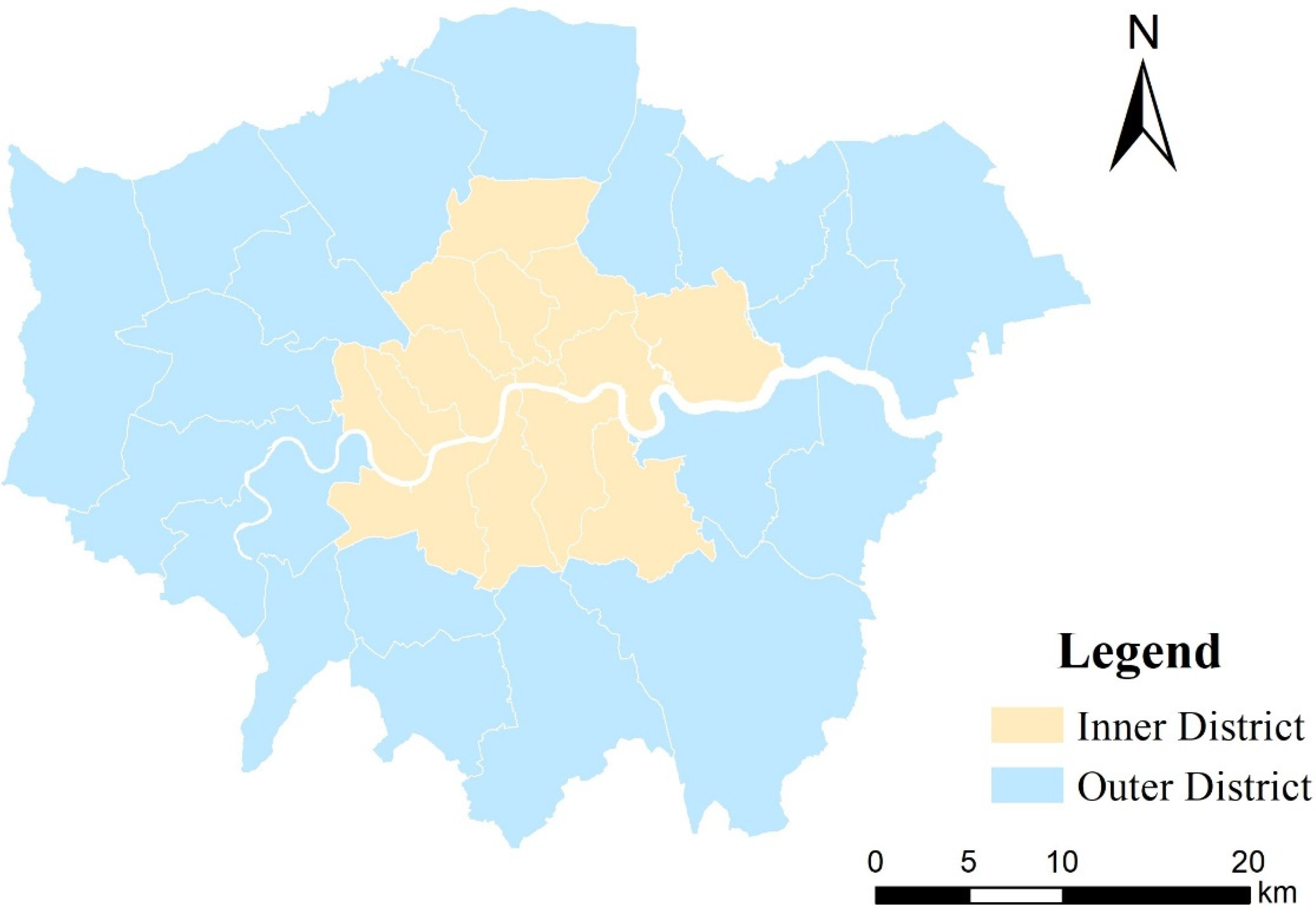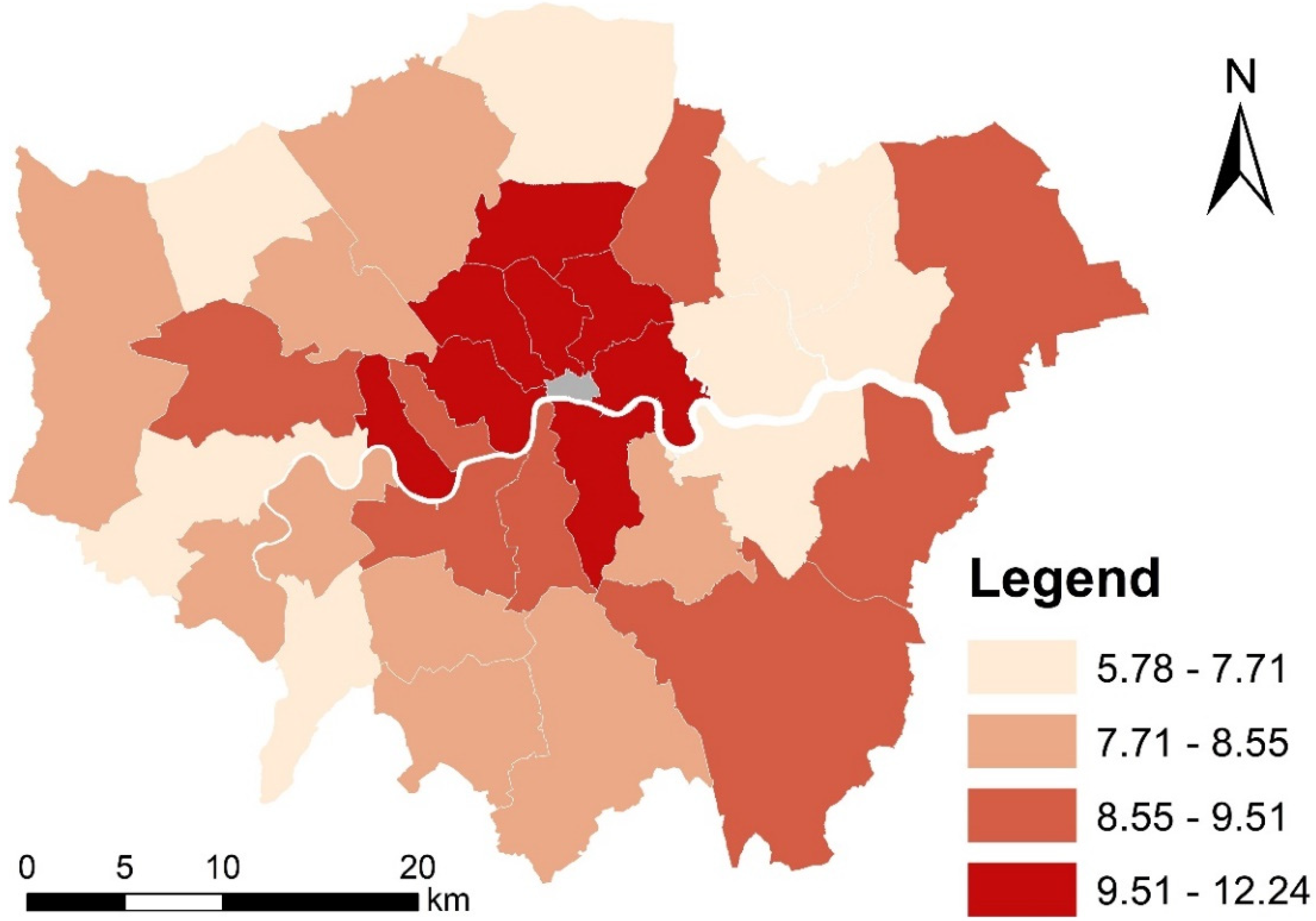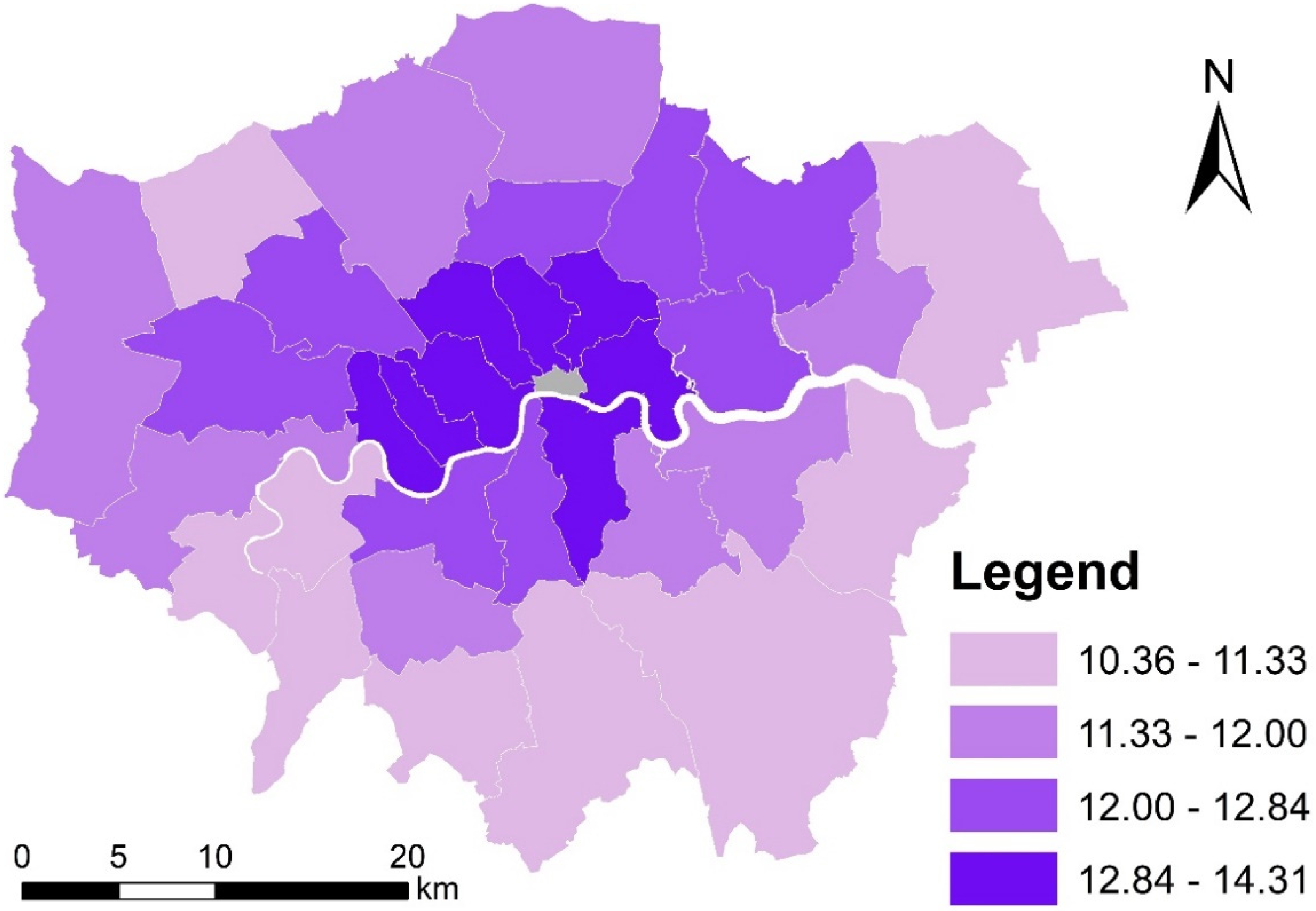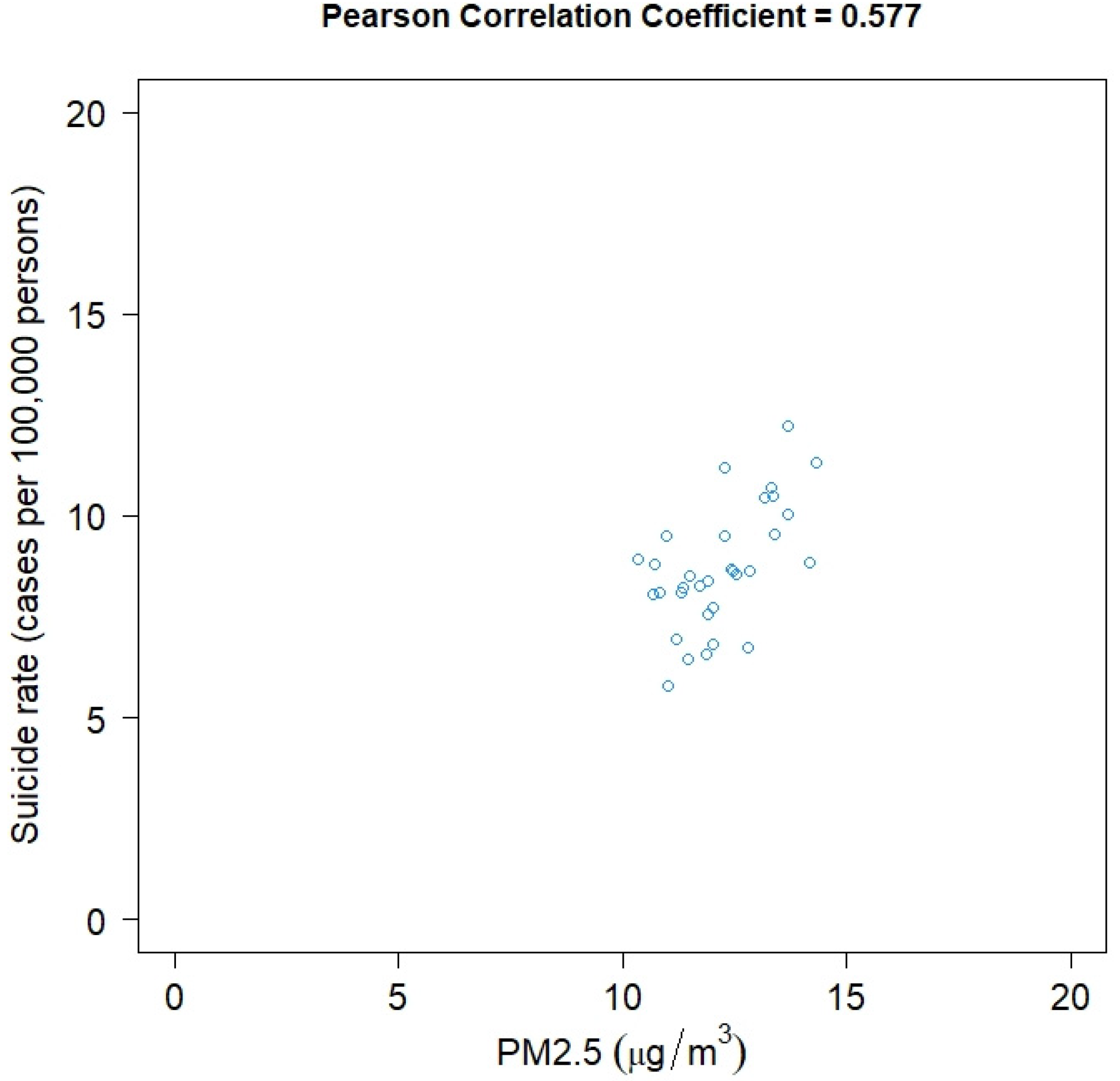Examining Spatial Association of Air Pollution and Suicide Rate Using Spatial Regression Models
Abstract
1. Introduction
2. Materials and Methods
2.1. Case Study and Data
2.2. Air pollution Level and Confounding Factors
2.3. Estimate Models
3. Empirical Analysis
3.1. Correlation of Suicide Rate and PM2.5 Level
3.2. Association of PM2.5 Level and Suicide Rate, Controlling for Socioeconomic Factors
3.3. Discussions
4. Conclusions and Future Work
Author Contributions
Funding
Acknowledgments
Conflicts of Interest
References
- Lipsett, M.J.; Ostro, B.D.; Reynolds, P.; Goldberg, D.; Hertz, A.; Jerrett, M.; Smith, D.F.; Garcia, C.; Chang, E.T.; Bernstein, L. Long-term exposure to air pollution and cardiorespiratory disease in the California teachers study cohort. Am. J. Respir. Crit. Care. Med. 2011, 184, 828–835. [Google Scholar] [CrossRef]
- Anderson, J.O.; Thundiyil, J.G.; Stolbach, A. Clearing the air: A review of the effects of particulate matter air pollution on human health. J. Med. Toxicol. 2012, 8, 166–175. [Google Scholar] [CrossRef] [PubMed]
- Pope, C.A., III; Turner, M.C.; Burnett, R.T.; Jerrett, M.; Gapstur, S.M.; Diver, W.R.; Krewski, D.; Brook, R.D. Relationships between fine particulate air pollution, cardiometabolic disorders, and cardiovascular mortality. Circ. Res. 2015, 116, 108–115. [Google Scholar] [CrossRef] [PubMed]
- Shah, A.S.; Lee, K.K.; McAllister, D.A.; Hunter, A.; Nair, H.; Whiteley, W.; Langrish, J.P.; Newby, D.E.; Mills, N.L. Short term exposure to air pollution and stroke: Systematic review and meta-analysis. BMJ 2015, 350, h1295. [Google Scholar] [CrossRef] [PubMed]
- Lu, J.G.; Lee, J.J.; Gino, F.; Galinsky, A.D. Polluted Morality: Air Pollution Predicts Criminal Activity and Unethical Behavior. Psychol. Sci. 2018, 29, 340–355. [Google Scholar] [CrossRef] [PubMed]
- Burkhardt, J.; Bayham, J.; Wilson, A.; Berman, J.D.; O’Dell, K.; Ford, B.; Fischer, E.V.; Pierce, J.R. The relationship between monthly air pollution and violent crime across the United States. Rev. Environ. Econ. Policy 2019, 1–18. [Google Scholar] [CrossRef]
- Ferretti, F.; Coluccia, A. Socio-economic factors and suicide rates in European Union countries. Leg. Med. 2009, 11, S92–S94. [Google Scholar] [CrossRef]
- Machado, D.B.; Rasella, D.; Dos Santos, D.N. Impact of income inequality and other social determinants on suicide rate in Brazil. PLoS ONE 2015, 10, e0124934. [Google Scholar] [CrossRef]
- Helbich, M.; Leitner, M.; Kapusta, N.D. Geospatial examination of lithium in drinking water and suicide mortality. Int. J. Health Geogr. 2012, 11, 19. [Google Scholar] [CrossRef]
- Pompili, M.; Vichi, M.; Dinelli, E.; Pycha, R.; Valera, P.; Albanese, S.; Lima, A.; de Vivo, B.; Cicchella, D.; Fiorillo, A.; et al. Relationships of local lithium concentrations in drinking water to regional suicide rates in Italy. World J. Biol. Psychiatry 2015, 16, 567–574. [Google Scholar] [CrossRef]
- Giotakos, O.; Tsouvelas, G.; Nisianakis, P.; Giakalou, V.; Lavdas, A.; Tsiamitas, C.; Panagiotis, K.; Kontaxakis, V. A negative association between lithium in drinking water and the incidences of homicides, in Greece. Biol. Trace Elem. Res. 2015, 164, 165–168. [Google Scholar] [CrossRef] [PubMed]
- Andrés, A.R.; Halicioglu, F.; Yamamura, E. Socio-economic determinants of suicide in Japan. Int. J. Soc. Econ. 2011, 40, 723–731. [Google Scholar] [CrossRef]
- Pompili, M.; Vichi, M.; Dinelli, E.; Erbuto, D.; Pycha, R.; Serafini, G.; Giordanoa, G.; Valera, P.; Albanese, S.; Lima, A.; et al. Arsenic: Association of regional concentrations in drinking water with suicide and natural causes of death in Italy. Psychiatry Res. 2017, 249, 311–317. [Google Scholar] [CrossRef] [PubMed]
- Helbich, M.; De Beurs, D.; Kwan, M.P.; O’Connor, R.C.; Groenewegen, P.P. Natural environments and suicide mortality in the Netherlands: A cross-sectional, ecological study. Lancet Planet. Health 2018, 2, e134–e139. [Google Scholar] [CrossRef]
- Vita, A.; De Peri, L.; Sacchetti, E. Lithium in drinking water and suicide prevention: A review of the evidence. Int. Clin. Psychopharmacol. 2015, 30, 1–5. [Google Scholar] [CrossRef] [PubMed]
- Rihmer, Z.; Hal, M.; Kapitány, B.; Gonda, X.; Vargha, M.; Döme, P. Preliminary investigation of the possible association between arsenic levels in drinking water and suicide mortality. J. Affect. Disord. 2015, 182, 23–25. [Google Scholar] [CrossRef]
- Biermann, T.; Stilianakis, N.; Bleich, S.; Thürauf, N.; Kornhuber, J.; Reulbach, U. The hypothesis of an impact of ozone on the occurrence of completed and attempted suicides. Med. Hypotheses 2009, 72, 338–341. [Google Scholar] [CrossRef]
- Szyszkowicz, M.; Willey, J.B.; Grafstein, E.; Rowe, B.H.; Colman, I. Air pollution and emergency department visits for suicide attempts in Vancouver, Canada. Environ. Health Insights 2010, 4, EHI-S5662. [Google Scholar] [CrossRef]
- Yang, A.C.; Tsai, S.J.; Huang, N.E. Decomposing the association of completed suicide with air pollution, weather, and unemployment data at different time scales. J. Affect. Disord. 2011, 129, 275–281. [Google Scholar] [CrossRef]
- Kim, Y.; Myung, W.; Won, H.H.; Shim, S.; Jeon, H.J.; Choi, J.; Carroll, B.J.; Kim, D.K. Association between air pollution and suicide in South Korea: A nationwide study. PLoS ONE 2015, 10, e0117929. [Google Scholar] [CrossRef]
- Bakian, A.V.; Huber, R.S.; Coon, H.; Gray, D.; Wilson, P.; McMahon, W.M.; Renshaw, P.F. Acute air pollution exposure and risk of suicide completion. Am. J. Epidemiol. 2015, 181, 295–303. [Google Scholar] [CrossRef]
- Gładka, A.; Rymaszewska, J.; Zatoński, T. Impact of air pollution on depression and suicide. Int. J. Occup. Med. Environ. Health 2018, 31, 711–721. [Google Scholar] [CrossRef]
- Casas, L.; Cox, B.; Bauwelinck, M.; Nemery, B.; Deboosere, P.; Nawrot, T.S. Does air pollution trigger suicide? A case-crossover analysis of suicide deaths over the life span. Eur. J. Epidemiol. 2017, 32, 973–981. [Google Scholar] [CrossRef] [PubMed]
- Ng, C.F.S.; Stickley, A.; Konishi, S.; Watanabe, C. Ambient air pollution and suicide in Tokyo, 2001–2011. J. Affect. Disord. 2016, 201, 194–202. [Google Scholar] [CrossRef] [PubMed]
- Min, J.Y.; Kim, H.J.; Min, K.B. Long-term exposure to air pollution and the risk of suicide death: A population-based cohort study. Sci. Total Environ. 2018, 628, 573–579. [Google Scholar] [CrossRef] [PubMed]
- Lee, H.; Myung, W.; Kim, S.E.; Kim, D.K.; Kim, H. Ambient air pollution and completed suicide in 26 South Korean cities: Effect modification by demographic and socioeconomic factors. Sci. Total Environ. 2018, 639, 944–951. [Google Scholar] [CrossRef]
- LeSage, J.P.; Pace, R.K. A matrix exponential specification. J. Econom. 2007, 140, 190–214. [Google Scholar] [CrossRef]
- LeSage, J.P.; Pace, R.K. Introduction to Spatial Econometrics; CRC Press: Boca Raton, FL, USA, 2009; Chapter 9. [Google Scholar]
- Tiefelsdorf, M.; Griffith, D.A. Semiparametric filtering of spatial autocorrelation: The eigenvector approach. Environ. Plan. 2007, 39, 1193–1221. [Google Scholar] [CrossRef]
- Murakami, D.; Griffith, D.A. Eigenvector spatial filtering for large data sets: Fixed and random effects approaches. Geogr. Anal. 2019, 51, 23–49. [Google Scholar] [CrossRef]
- Murakami, D.; Griffith, D.A. Random effects specifications in eigenvector spatial filtering: A simulation study. J. Geogr. Syst. 2015, 17, 311–331. [Google Scholar] [CrossRef]
- Bhui, K.S.; Dinos, S.; McKenzie, K. Ethnicity and its influence on suicide rates and risk. Ethn. Health 2012, 17, 141–148. [Google Scholar] [CrossRef]
- Wetherall, K.; Daly, M.; Robb, K.A.; Wood, A.M.; O’Connor, R.C. Explaining the income and suicidality relationship: Income rank is more strongly associated with suicidal thoughts and attempts than income. Soc. Psychiatry Psychiatr. Epidemiol. 2015, 50, 929–937. [Google Scholar] [CrossRef] [PubMed]
- Szyszkowicz, M.; Kousha, T.; Kingsbury, M.; Colman, I. Air pollution and emergency department visits for depression: A multicity case-crossover study. Environ. Health Insights 2016, 10, EHI-S40493. [Google Scholar] [CrossRef]
- Tondo, L.; Isacsson, G.; Baldessarini, R. Suicidal behaviour in bipolar disorder: Risk and prevention. CNS Drugs 2003, 17, 491–511. [Google Scholar] [CrossRef] [PubMed]
- Pun, V.C.; Manjourides, J.; Suh, H. Association of ambient air pollution with depressive and anxiety symptoms in older adults: Results from the NSHAP study. Environ. Health Perspect. 2017, 125, 342–348. [Google Scholar] [CrossRef] [PubMed]
- He, G.; Chen, Y.; Wang, S.; Dong, Y.; Ju, G.; Chen, B. The Association between PM2.5 and Depression in China. Dose-Response 2020, 18. [Google Scholar] [CrossRef] [PubMed]




| Borough | Suicide Rate | PM2.5 Level | Borough | Suicide Rate | PM2.5 Level | Borough | Suicide Rate | PM2.5 Level |
|---|---|---|---|---|---|---|---|---|
| Barking and Dagenham | 7.56 | 11.90 | Hammersmith and Fulham | 10.70 | 13.34 | Merton | 8.51 | 11.50 |
| Barnet | 8.28 | 11.72 | Haringey | 11.18 | 12.28 | Newham | 6.74 | 12.79 |
| Bexley | 9.51 | 10.99 | Harrow | 5.78 | 11.01 | Redbridge | 7.71 | 12.01 |
| Brent | 8.55 | 12.55 | Havering | 8.78 | 10.71 | Richmond upon Thames | 8.11 | 11.33 |
| Bromley | 8.93 | 10.36 | Hillingdon | 8.20 | 11.34 | Southwark | 10.43 | 13.17 |
| Camden | 10.48 | 13.37 | Hounslow | 6.84 | 12.00 | Sutton | 8.05 | 10.68 |
| Croydon | 8.12 | 10.83 | Islington | 12.24 | 13.68 | Tower Hamlets | 10.04 | 13.69 |
| Ealing | 8.62 | 12.46 | Kensington and Chelsea | 8.83 | 14.17 | Waltham Forest | 8.68 | 12.44 |
| Enfield | 6.44 | 11.47 | Kingston upon Thames | 6.93 | 11.21 | Wandsworth | 9.50 | 12.27 |
| Greenwich | 6.58 | 11.87 | Lambeth | 8.63 | 12.84 | Westminster | 11.31 | 14.31 |
| Hackney | 9.53 | 13.39 | Lewisham | 8.37 | 11.91 |
| Variables | Full Names | Years | Mean | SD |
|---|---|---|---|---|
| DSRS | Directly age-standardised rate of suicides (cases per 100,000 persons) | 2011–2015 | 8.69 | 1.52 |
| DT | District type | - | - | - |
| ML_P | Percent of males aged 16 and over (%) | 2010–2014 | 49.42 | 0.97 |
| WHT_P | Percent of White people (%) | 2012–2014 | 61.3 | 14.85 |
| INC_M | Average median annual household income (1000£) | 2010–2012 | 50.82 | 15.6 |
| UNE_R | Unemployment rate (%) | 2010–2014 | 8.58 | 1.88 |
| NQL_P | Percent of working-age population with no qualifications (%) | 2010–2014 | 8.68 | 2.74 |
| JOB_D | Job density (jobs/persons) | 2011–2015 | 0.86 | 0.72 |
| PM2.5 | Population-weighted annual mean PM2.5 level (μg/m3) | 2012–2014 | 12.17 | 1.07 |
| Parameter | Response: DSRS | |
|---|---|---|
| MESS-SAR | RES-ESF | |
| Intercept | 4.634 | 3.742 |
| BR_T ‘Outer’ | 1.004 | 0.963 |
| ML_P | −0.401 | −0.384 |
| WHT_P | 0.068 * | 0.067 * |
| M_INC | −0.065 * | −0.064 * |
| UNE_R | 0.090 | 0.052 |
| NQL_R | −0.211 | −0.177 |
| JOB_D | 0.468 | 0.482 |
| PM2.5 | 2.102 *** | 1.982 *** |
| Adjusted R-squared | 0.600 | 0.469 |
| AIC | 102.195 | 125.665 |
© 2020 by the authors. Licensee MDPI, Basel, Switzerland. This article is an open access article distributed under the terms and conditions of the Creative Commons Attribution (CC BY) license (http://creativecommons.org/licenses/by/4.0/).
Share and Cite
Sun, Y.; Chan, T.O.; Xie, J.; Sun, X.; Huang, Y. Examining Spatial Association of Air Pollution and Suicide Rate Using Spatial Regression Models. Sustainability 2020, 12, 7444. https://doi.org/10.3390/su12187444
Sun Y, Chan TO, Xie J, Sun X, Huang Y. Examining Spatial Association of Air Pollution and Suicide Rate Using Spatial Regression Models. Sustainability. 2020; 12(18):7444. https://doi.org/10.3390/su12187444
Chicago/Turabian StyleSun, Yeran, Ting On Chan, Jing Xie, Xuan Sun, and Ying Huang. 2020. "Examining Spatial Association of Air Pollution and Suicide Rate Using Spatial Regression Models" Sustainability 12, no. 18: 7444. https://doi.org/10.3390/su12187444
APA StyleSun, Y., Chan, T. O., Xie, J., Sun, X., & Huang, Y. (2020). Examining Spatial Association of Air Pollution and Suicide Rate Using Spatial Regression Models. Sustainability, 12(18), 7444. https://doi.org/10.3390/su12187444







